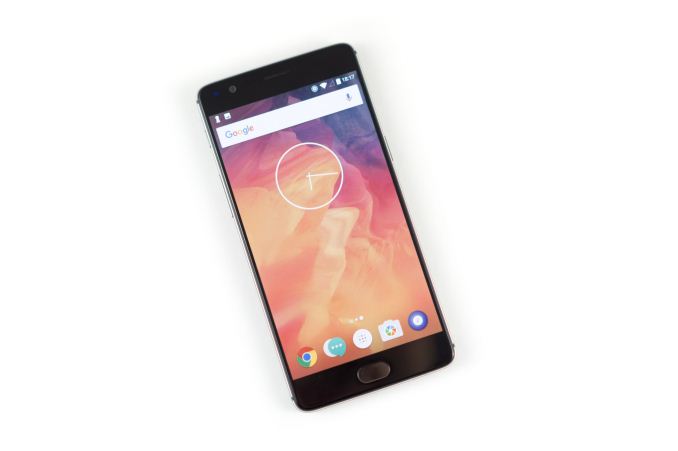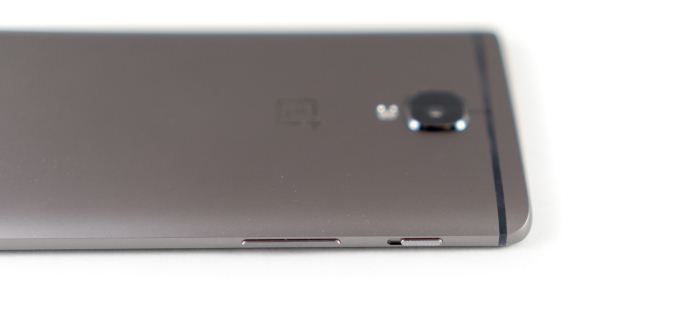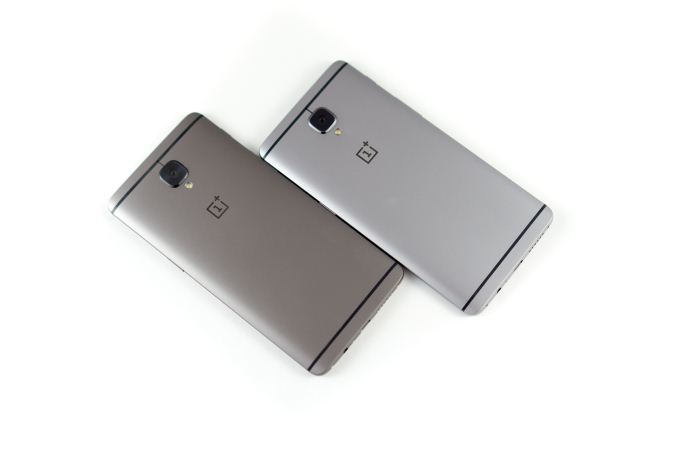The OnePlus 3T Review
by Brandon Chester on November 28, 2016 10:30 AM EST- Posted in
- Smartphones
- OnePlus
- OnePlus 3T

Back in June, OnePlus launched their new flagship smartphone, the OnePlus 3. I've had an interesting relationship with the OnePlus 3 due to certain decisions that were made regarding its display and some parts of the operating system before the phone initially launched. Since that time, OnePlus has made significant improvements to both of these aspects, and in my follow up piece I concluded that the OnePlus 3 should be considered by all smartphone buyers, even ones who were ready to pay $700 or $800 for a flagship phone from another company.
Earlier this month, OnePlus surprised a number of people in the Android community by launching a successor to the OnePlus 3. This move isn't in line with the yearly cadence that we've come to expect for their smartphones, which makes it all the more interesting. The name of this new phone is the OnePlus 3T, and based on that name one can already see that it represents an evolution of the OnePlus 3 rather than a revolutionary upgrade. As the OnePlus 3's successor, the OnePlus 3T simply serves to update certain aspects of the phone's hardware in order to take advantage of technology improvements that have been made available since the OnePlus 3 was originally developed and released.
This review focuses on the aspects of the OnePlus 3T that differ from its predecessor. Because of that, I recommend reading over my review of the OnePlus 3 if you're interested in other aspects of the phone like the camera quality. Before moving on, I've collected all the specifications for the OnePlus 3 and 3T in the chart below to make it clear which parts have changed and which have remained the same.
| OnePlus 3 | OnePlus 3T | ||
| SoC | Qualcomm Snapdragon 820 2 x 2.15GHz Kryo 2 x 1.6GHz Kryo 624MHz Adreno 530 |
Qualcomm Snapdragon 821 2 x 2.35GHz Kryo 2 x 1.6GHz Kryo 653MHz Adreno 530 |
|
| RAM | 6GB LPDDR4 | ||
| Display | 5.5" 1920 x 1080 PenTile AMOLED | ||
| Size / Mass | 152.7 x 74.7 x 7.35mm, 158g | ||
| Battery | 3000 mAh | 3400 mAh | |
| Rear Camera | 16MP 1.1 μm Sony IMX298, f/2.0, OIS | ||
| Front Camera | 8MP 1.4 μm Sony IMX179, f/2.0 |
16MP 1.0 µm Samsung S5K3P8, f/2.0 |
|
| Storage | 64GB UFS 2.0 | 64/128GB UFS 2.0 | |
| I/O | USB 2.0 Type-C connector, 3.5mm audio | ||
| Connectivity | 1x1 802.11a/b/g/n/ac + BT 4.2, USB-C, GPS/GNSS | ||
| Software | Android 6.0.1 OxygenOS 3.2.8 |
Android 6.0.1 OxygenOS 3.5.1 |
|
| Price | 64GB 399 USD |
64GB 439 USD 439 EUR 399 GBP 599 CAD |
128GB 479 USD 479 EUR 439 GBP 639 CAD |
For the most part, the OnePlus 3T is the same as the OnePlus 3. The size and mass are both the same, the display is the same, the rear-camera is the same, and the connectivity is the same. Internally OnePlus has made some changes to certain components. The most obvious change is the new SoC, with Snapdragon 820 being replaced with a faster Snapdragon 821 chip, while the RAM remains a healthy 6GB of LPDDR4. The battery capacity has also increased from 3000mAh to 3400mAh, which is a 13% increase without any change in the size or mass of the phone. The last major change is the new front-facing camera, which has moved from the 8MP 1.4µm Sony sensor on the OnePlus 3 to a 16MP 1.0µm Samsung sensor. In addition to the changes across all models, OnePlus has also introduced a 128GB SKU for users who need more storage. All of these changes also come at a higher price, with the 64GB model starting at $439, up from $399, and the 128GB model coming in at $479.
Design
As far as its design goes, the OnePlus 3T is mostly unchanged from its predecessor. I'm quite a fan of the OnePlus 3's design, so I don't feel that there was any need to change it significantly. The relatively thin body and the tapered back design make it far more usable with one hand than other 5.5" smartphones like the Pixel XL or the Moto G4. Being made from a single piece of aluminum, the chassis has none of the seams that the OnePlus One and OnePlus 2 had, and it feels incredibly solid in the hand. Unlike certain other vendors, OnePlus has also taken the time to actually align the various ports and buttons on the sides of the chassis instead of placing them wherever is convenient without any regard for aesthetics or usability.
Beyond the purely physical aspects of the design, I think OnePlus's design decisions regarding the placement of controls also makes the phone easier to use than competing devices. Having been using the OnePlus 3 since launch, I can say with certainty that OnePlus is on the right side of history by putting the volume rocker on the left side of the phone along with a physical switch for toggling notification settings. I also really appreciate having capacitive navigation buttons instead of wasting space on the display with on-screen buttons sitting above a bottom bezel that could easily fit physical ones. Putting the fingerprint scanner on the front of the phone as part of the home button also makes it simple to turn on and unlock the phone, even if it's sitting on a table.
The only aspect of the design that has changed from the OnePlus 3 is the color of the phone. The OnePlus 3 was originally available in a standard silver aluminum finish and later came in a gold finish, while the OnePlus 3T comes in a gunmetal grey finish and a gold finish from the start. The gold finish is only available in a 64GB capacity, while the gunmetal has both a 64GB and a 128GB version. For this review the 128GB gunmetal model was sampled, and I think it's a nice look for the phone. It's certainly not as dark as Apple's black iPhone 7 finish, but it's visibly darker than the OnePlus 3's aluminum and helps to distinguish between the two. I wouldn't have minded if OnePlus had also kept the standard silver finish available, as I think it looked rather nice as well, but I don't think the gunmetal is such a dramatic change in color that users will be bothered by silver being unavailable.












104 Comments
View All Comments
adityarjun - Monday, November 28, 2016 - link
"The only change that actually does impact the user in a visible and meaningful way is the improved battery life."And the fact that you can't game on it anymore apparently.
xenol - Monday, November 28, 2016 - link
Any samples of the pictures the camera takes?Ian Cutress - Monday, November 28, 2016 - link
As mentioned directly in the review, the 3T shares a number of identical parts and software elements. One of these is the camera. We've only focused on the main changes for this review, rather than reposting most of the OP3 review again. So refer to the OP3 review :http://www.anandtech.com/show/10411/the-oneplus-3-...
realbabilu - Tuesday, November 29, 2016 - link
No love for front camera upgrade samples? Selfies anyone.I hope their night scene for main camera have been a little bit better at 3T,
Ironchef3500 - Monday, November 28, 2016 - link
Anybody else disappointed at the Pixel performance?amdwilliam1985 - Monday, November 28, 2016 - link
Yep, I believe Anandtech is the only reputable website/source on the internet that didn't like the Pixel phones, everyone else is raving how great they are, including all the non-tech users. Well, I was so tempted to upgrade to Pixel XL after seeing all the youtube/website raves, thanks to Anandtech, I'm saving my money and going for the next version. I got a 6P, bought 2 pairs of dbrand skins on Black Friday, the new skins and Android 7.1.1 will make a new phone out of my 6P :)I guess Google is focusing on optimizing the user experience while everyone is still chasing after benchmarks(including Apple, T_T for Apple after Steve Jobs, next year Tim Crook will introduce 3 iPads with 4 iPhones for every possible market segmentation to make even more money that they'll never use).
Techgeek43 - Monday, November 28, 2016 - link
Brandon, great article, as always. One question I have, is it a mimo chip on the WiFi ? Does it have top speed of 433 or 867 ?Brandon Chester - Tuesday, November 29, 2016 - link
433Mbps. I've added that to the chart on the first page as well.Techgeek43 - Wednesday, November 30, 2016 - link
Thank youzepi - Monday, November 28, 2016 - link
Any change that Anandtech could take a look at OLED burn-in / durability issues? There is lot of talk about this and I've personally seen many oled phones / tablets in shops having clear burn-in issues, but afaik no big tech-site has done real reviews.Ie. source 1 and 2 year old used daily-driver OLED phones that you've reviewed earlier and run the display calibration benchmarks again. It'd be interesting to see how well Galaxy S5's and S6'es fare after being used 1-2 years in terms of max brightness, image retention and colour balance.
Obviously, it wouldn't hurt to run comparison measurements from a similarly aged LCD phone like iPhone 6 or something like that.